Common bean (Phaseolus vulgaris L.) and chickpea (Cicer arietinum L.) are the most important grain legumes in Ethiopia. Most of the Ethiopian soils are deficient of soil nitrogen, thereby reducing crop production far below potential. However, common bean (hereafter referred to as “bean”) and chickpea can form symbiotic associations with soil bacteria called rhizobia and fix atmospheric nitrogen inside a root nodule. The fixed nitrogen is then used for growth and development of the plant. Symbiotic nitrogen fixation is partly affected by the genotypes of the interacting legume and rhizobia.
As part of N2Africa-Ethiopia, this PhD project aims to investigate the legume genotype (GL) x rhizobium genotype (GR) interactions in chickpea and bean in terms of their symbiotic effectiveness. Bean and chickpea genotypes and rhizobium strains were selected based on their phylogenetic distances. The selected genotypes and strains were factorially combined and tested in modified Leonard Jars (Somasegaran and Hoben, 1994; Howieson and Dilworth, 2016) using an RCBD design with five replications. After 45 days of growth, plant phenotypes were assessed for nodulation (nod+/nod-) and nitrogen fixation (fix+/fix-), respectively. Plants with nod+/fix+ phenotypes were screened for further investigation in pots.
Rhizobium strains CIAT899 (Figure 1) and NAK-91 formed symbiotically effective nodules across all the tested bean genotypes, whereas the other strains had varied nodulation and N2-fixation phenotypes (Figure 2). Some of the legume genotypes were nodulated by most of the strains tested, indicating that they can effectively fix nitrogen if inoculated by any of these strains.
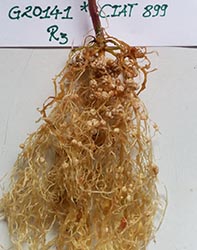
|
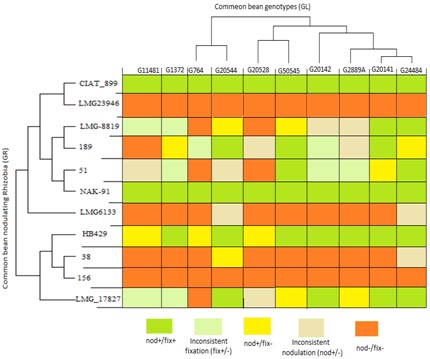
|
In chickpea, the interactions between GL and GR were relatively uniform in their effects on nodulation and fixation phenotypes. Most of the strains were able to form effective nodules (Figure 3) on all of the tested chickpea genotypes (Figure 4). This implies intense competition among the soil rhizobial populations to infect a given chickpea genotype.
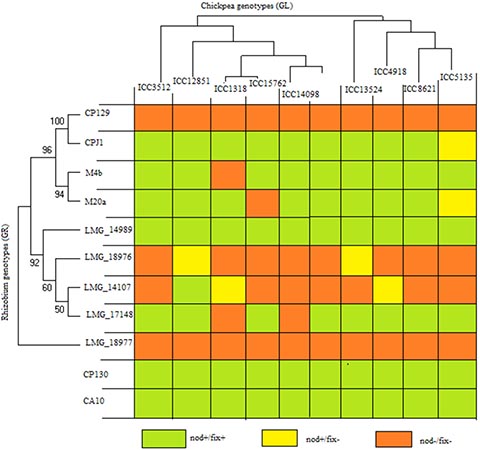
|
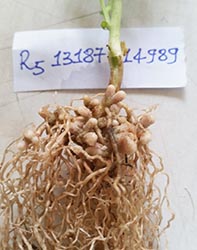
ICC13187 inoculated with LMG14989 |
Based on the jar experiment, five bean genotypes (G1372, G20141, G20142, G20544 and G24484) and seven bean rhizobia (CIAT899, NAK-91, LMG17827, LMG8819, HB429, 51 (NAE-HB-12-N4) and 189 (NAE-HB-39-L1) were selected for further investigation in pot. The pot experiment (Figure 5) was set following the methods described in Howieson and Dilworth (2016). Similarly, seven chickpea strains (LMG14989, CA10, Cp130, CPJ1, M4b, LMG17148 and M20a) and 5 chickpea genotypes (ICC12851, ICC13524, ICC8621, ICC9434 and ICC6263) were selected and are now under investigation.
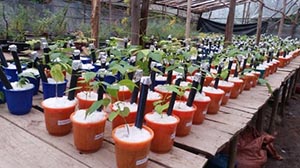
|
In conclusion, investigation of GL x GR interactions in jars helped to screen a number of rhizobium strains and legume genotypes and select the most promising ones for a follow-up pot experiment.
Acknowledgement: I am very much grateful to Wageningen University, Hawassa University and N2Africa Project for technical, material and financial supports. I would also like to acknowledge CIAT for providing common bean genotypes and ICRISAT for providing chickpea genotypes.
Ashenafi Hailu Gunnabo, Wageningen University & Research, The Netherlands (Click here for his 2016 update)
References:
Somasegaran, P. and Hoben, H.J. (1994). Handbook for Rhizobia: Methods in Legume Rhizobium Technology. Springer-Verlag, New York.
Howieson, J.G. and Dilworth, M.J. (Eds.) (2016). Working with rhizobia. Australian Centre for International Agricultural Research (ACIAR), Canberra.
